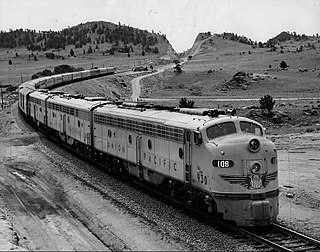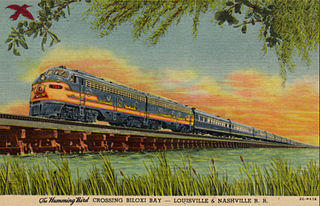
The City of Portland was a named passenger train operated by the Union Pacific Railroad between Chicago, Illinois, and Portland, Oregon. It started service in June 1935, using the streamlined M-10001 trainset. With only one set of equipment the train left each of its terminals five times a month. The route used Chicago and Northwestern trackage between Chicago and Omaha, Nebraska until 1955, replaced by Milwaukee Road trackage.

The Super Chief was one of the named passenger trains and the flagship of the Atchison, Topeka and Santa Fe Railway. The streamliner claimed to be "The Train of the Stars" because of the various celebrities it carried between Chicago, Illinois, and Los Angeles, California.

The City of Denver was a streamlined passenger train operated by the Union Pacific Railroad between Chicago, Illinois, and Denver, Colorado. It operated between 1936 and 1971. From 1936–1955 the Chicago and North Western Railway handled the train east of Omaha, Nebraska; the Chicago, Milwaukee, St. Paul and Pacific Railroad handled it thereafter. The train was the fastest long-distance train in the United States when it debuted in 1936, covering 1,048 miles (1,687 km) in 16 hours. For almost its entire career its principal competitor was the Chicago, Burlington and Quincy Railroad's Denver Zephyr. When Amtrak assumed operation of most intercity trains in the United States in 1971, it discontinued the City of Denver, preferring to use the Burlington's route between Chicago and Denver.

The Louisville and Nashville Railroad, commonly called the L&N, was a Class I railroad that operated freight and passenger services in the southeast United States.

The M-10000 was an early American streamlined passenger trainset that operated for the Union Pacific Railroad from 1934 until 1941. It was the first streamlined passenger train to be delivered in the United States, and the second to enter regular service after the Pioneer Zephyr of the Chicago, Burlington and Quincy Railroad.

The Union Pacific Railroad's M-10001 was a diesel-electric streamlined train built in 1934 by Pullman-Standard with a power system developed by General Motors Electro-Motive Corporation using a Winton 201A Diesel engine and General Electric generator, control equipment and traction motors. It was the UP's second streamliner after the M-10000, their first equipped with a diesel engine and was a much longer train than its three-car predecessor. All cars were articulated—trucks were shared between each car. It was delivered on October 2, 1934, and was used for display, test and record-setting runs for the next two months before being returned to Pullman-Standard for an increase in its power and capacity, following which it was placed into service as the City of Portland train. It has been nicknamed "The Banana".

The Chicago and Eastern Illinois Railroad was a Class I railroad that linked Chicago to southern Illinois, St. Louis, and Evansville. Founded in 1877, it grew aggressively and stayed relatively strong throughout the Great Depression and two World Wars before finally being purchased by the Missouri Pacific Railroad and the Louisville and Nashville Railroad (L&N). Missouri Pacific merged with the C&EI corporate entity in 1976, and was later acquired itself by the Union Pacific Railroad.

The Panama Limited was a passenger train operated from 1911 to 1971 between Chicago, Illinois, and New Orleans, Louisiana. The flagship train of the Illinois Central Railroad, it took its name from the Panama Canal, which in 1911 was three years from completion. For most of its career, the train was "all-Pullman", carrying sleeping cars only. The Panama Limited was one of many trains discontinued when Amtrak began operations in 1971, though Amtrak revived the name later that year and continued it until 1981.

The George Washington was a named passenger train of the Chesapeake and Ohio Railway running between Cincinnati, Ohio and Washington, D.C. A section divided from the main train at Gordonsville, Virginia and operated through Richmond to Phoebus, Virginia. From the west, a section originated in Louisville and joined at Ashland. The train began service in 1932 to mark the 200th anniversary of the birth of the first president of the United States.

The Challengers were named passenger trains on the Union Pacific Railroad and the Chicago and North Western Railway. The economy service ran between Chicago, Illinois, and the West Coast of the United States. The trains had full Pullman service and coach seating and were an attempt to draw Depression-Era riders back to the rails. Food service was advertised as "three meals for under a dollar a day."

The Humming Bird was a named train of the Louisville and Nashville Railroad (L&N). The train, inaugurated in 1946, originally ran from Cincinnati, Ohio, to New Orleans, Louisiana, via Louisville, Nashville, Birmingham, Montgomery and Mobile and later via a connection at Bowling Green, Kentucky, to Memphis, Tennessee. A connection to Chicago was provided by the Chicago and Eastern Illinois Railroad.
The South Wind was a named passenger train equipped and operated jointly by the Pennsylvania Railroad, the Louisville and Nashville Railroad, the Atlantic Coast Line Railroad, and the Florida East Coast Railway. The South Wind began operations in December 1940, providing streamliner service between Chicago, Illinois and Miami, Florida. This was one of three new seven-car, all-coach streamliners operating in coordination every third day along different routes between Chicago and Miami. The other two longest enduring Chicago-Florida trains were the City of Miami and the Dixie Flagler. The South Wind remained in service through the creation of Amtrak in 1971.

The Alton Limited was the Chicago & Alton Railway's (C&A) flagship service between Chicago, Illinois and St. Louis, Missouri. It was introduced in 1899, re-equipped in 1905 and again in 1924. The name and service was ultimately discontinued in late 1971.

The Dixie Flagler was a streamlined passenger train operated by the Florida East Coast Railway (FEC) between Chicago, Illinois and Miami, Florida. It began in 1939 as the Henry M. Flagler, a regional service between Miami and Jacksonville, Florida; the FEC renamed it and extended it to Chicago a year later. It was one of the few Chicago to Florida trains that passed through Atlanta. As an overnight streamliner it was part of the every-third-day pool shared by the City of Miami and South Wind. It was renamed Dixieland in 1954 and discontinued altogether in 1957.

The Pere Marquette was a streamlined passenger train operated by the Pere Marquette Railway and its successor the Chesapeake and Ohio Railway (C&O) between Detroit and Grand Rapids, Michigan. It operated from 1946 to 1971. It was the first new streamliner to enter service after World War II. Although discontinued in 1971 on the formation of Amtrak, in 1984 Amtrak revived the name for a new train between Chicago, Illinois and Grand Rapids.

The Blue Bird was a streamlined passenger train operated by the Wabash Railroad and its successor the Norfolk and Western Railway between Chicago, Illinois, and St. Louis, Missouri. It operated from 1938 to 1971. Beginning in 1950 it was one of the few Wabash passenger trains to carry a dome car and the first dome train in regular operation between the two cities. The train was cut back to Decatur, Illinois, in 1968 and renamed City of Decatur. Amtrak did not retain the City of Decatur, and it made its last run on April 30, 1971.

The Meadowlark was a streamlined passenger train operated by the Chicago and Eastern Illinois Railroad between Chicago, Illinois and Cypress, Illinois. It operated from 1946 to 1962. The Meadowlark was the C&EI's last train to Southern Illinois.

The Dixie Flyer was a premier named passenger train that operated from 1892 to 1965 via the "Dixie Route" from Chicago and St. Louis via Evansville, Nashville, and Atlanta to Florida. However, the train persisted to 1969 as an Atlanta to Florida operation, solely run by the Atlantic Coast Line Railroad and its successor. The Flyer's route varied in early years, but by about 1920 was set as follows:
The Georgian was a long distance passenger train operated by the Louisville and Nashville Railroad in conjunction with the Chicago and Eastern Illinois Railroad. It was operated between St. Louis Union Station and Atlanta's Union Station with a section operated by the C&EI from Evansville to Chicago's Dearborn Station. From Nashville to Atlanta it operated over the tracks of the Nashville, Chattanooga and St. Louis Railway. With the introduction of this train, this made the C&EI's Chicago-Evansville Whippoorwill train superfluous.
















